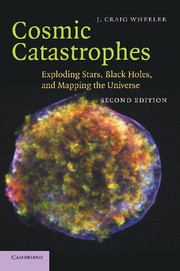Book contents
- Frontmatter
- Contents
- Preface
- 1 Setting the stage: star formation and hydrogen burning in single stars
- 2 Stellar death: the inexorable grip of gravity
- 3 Dancing with stars: binary stellar evolution
- 4 Accretion disks: flat stars
- 5 White dwarfs: quantum dots
- 6 Supernovae: stellar catastrophes
- 7 Supernova 1987A: lessons and enigmas
- 8 Neutron stars: atoms with attitude
- 9 Black holes in theory: into the abyss
- 10 Black holes in fact: exploring the reality
- 11 Gamma-ray bursts, black holes and the Universe: long, long ago and far, far away
- 12 Supernovae and the Universe
- 13 Wormholes and time machines: tunnels in space and time
- 14 Beyond: the frontiers
- Index
10 - Black holes in fact: exploring the reality
Published online by Cambridge University Press: 14 September 2009
- Frontmatter
- Contents
- Preface
- 1 Setting the stage: star formation and hydrogen burning in single stars
- 2 Stellar death: the inexorable grip of gravity
- 3 Dancing with stars: binary stellar evolution
- 4 Accretion disks: flat stars
- 5 White dwarfs: quantum dots
- 6 Supernovae: stellar catastrophes
- 7 Supernova 1987A: lessons and enigmas
- 8 Neutron stars: atoms with attitude
- 9 Black holes in theory: into the abyss
- 10 Black holes in fact: exploring the reality
- 11 Gamma-ray bursts, black holes and the Universe: long, long ago and far, far away
- 12 Supernovae and the Universe
- 13 Wormholes and time machines: tunnels in space and time
- 14 Beyond: the frontiers
- Index
Summary
THE SEARCH FOR BLACK HOLES
Black holes, those made from stars, are really black! How can we hope to find them if they do exist? Some solitary massive stars may collapse to make isolated black holes drifting through the emptiness of space. There could be very many of these black holes. Estimates based on the number of massive stars that have died in the history of our Galaxy range from one to a hundred million black holes. The simple fact is that, until a space probe stumbles into one, we are likely never to detect this class of isolated, single black holes. We will certainly never see the black hole itself in any circumstances because no light emerges from it. Our only chance to detect the presence of a black hole is to find a situation where mass is plunging down a black hole, heats, and radiates. We can hope to detect the halo of radiation from such an accreting black hole, even if we never see the black hole itself. Black holes are so strange and so significant that the standard of proof must be exceedingly high. As we will see, the evidence is very strong, but still largely circumstantial.
Many astronomers search for giant black holes in the centers of galaxies. The evidence for those black holes has become rather strong in the last few years, but most of the evidence still involves matter moving far beyond the event horizon, and we know very little about the configuration of the accreting matter.
- Type
- Chapter
- Information
- Cosmic CatastrophesExploding Stars, Black Holes, and Mapping the Universe, pp. 207 - 228Publisher: Cambridge University PressPrint publication year: 2007



